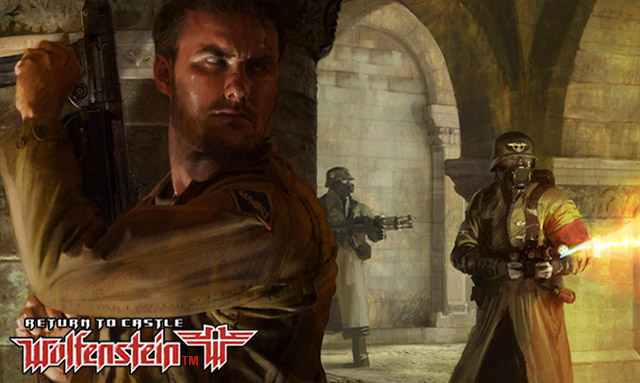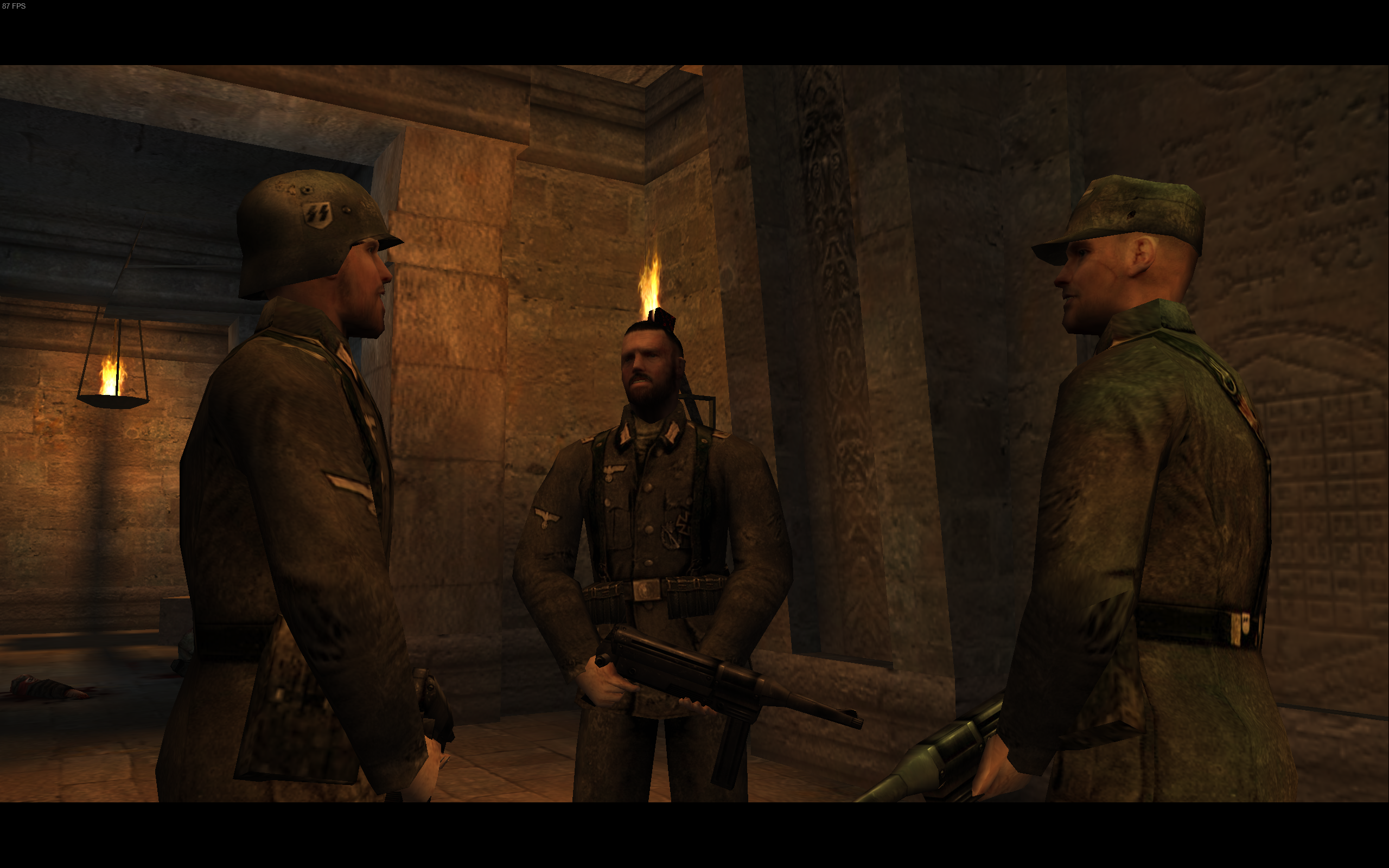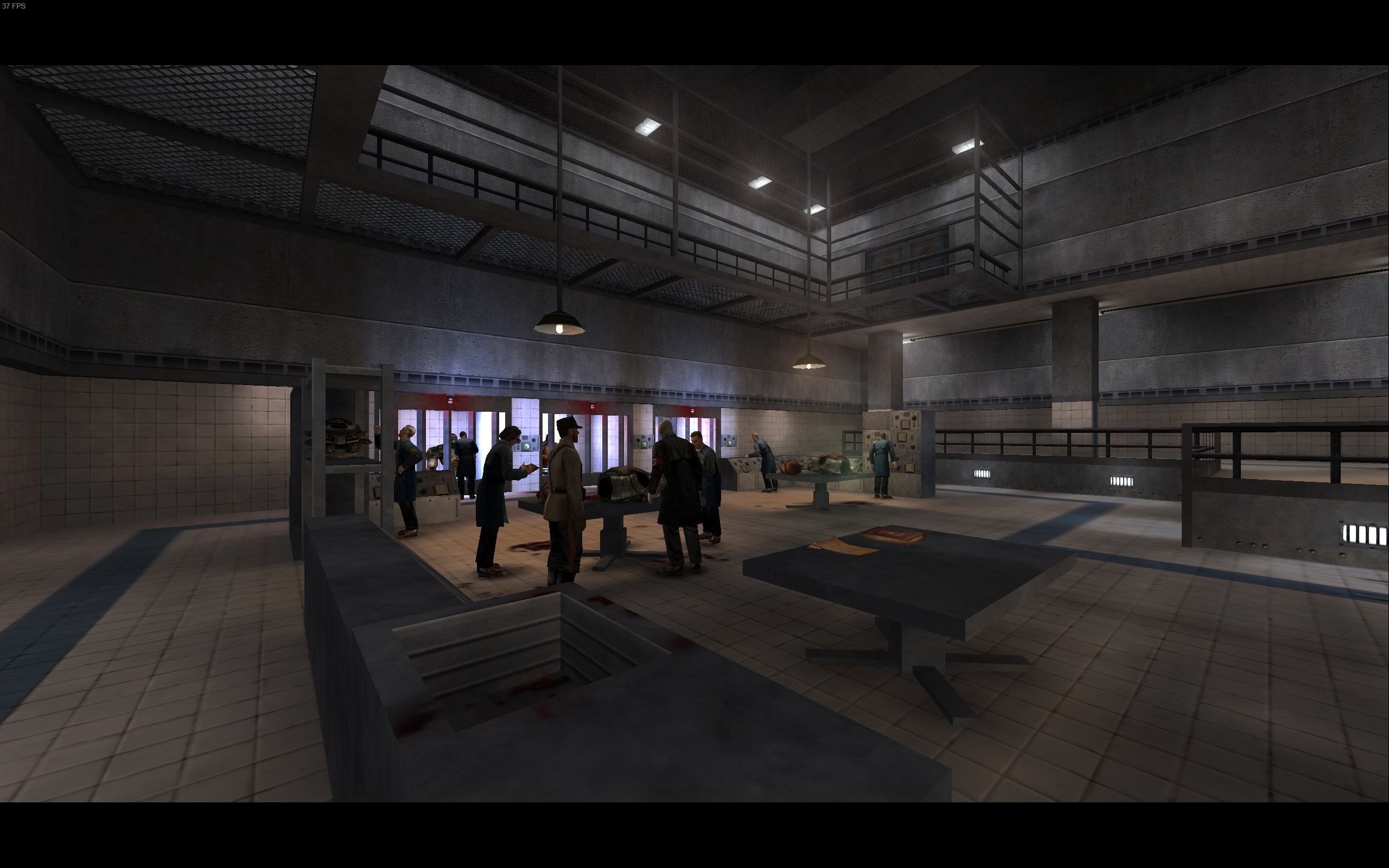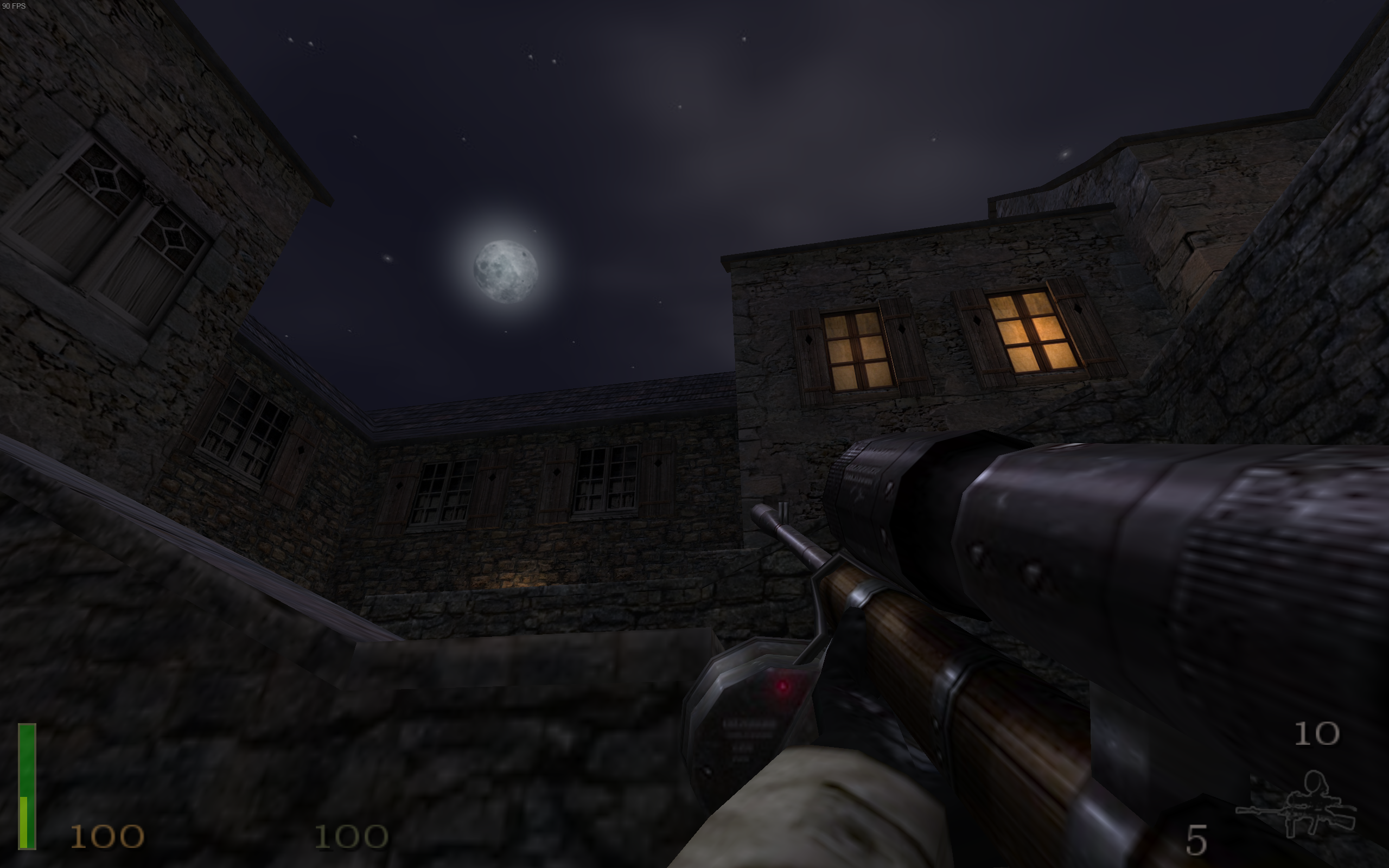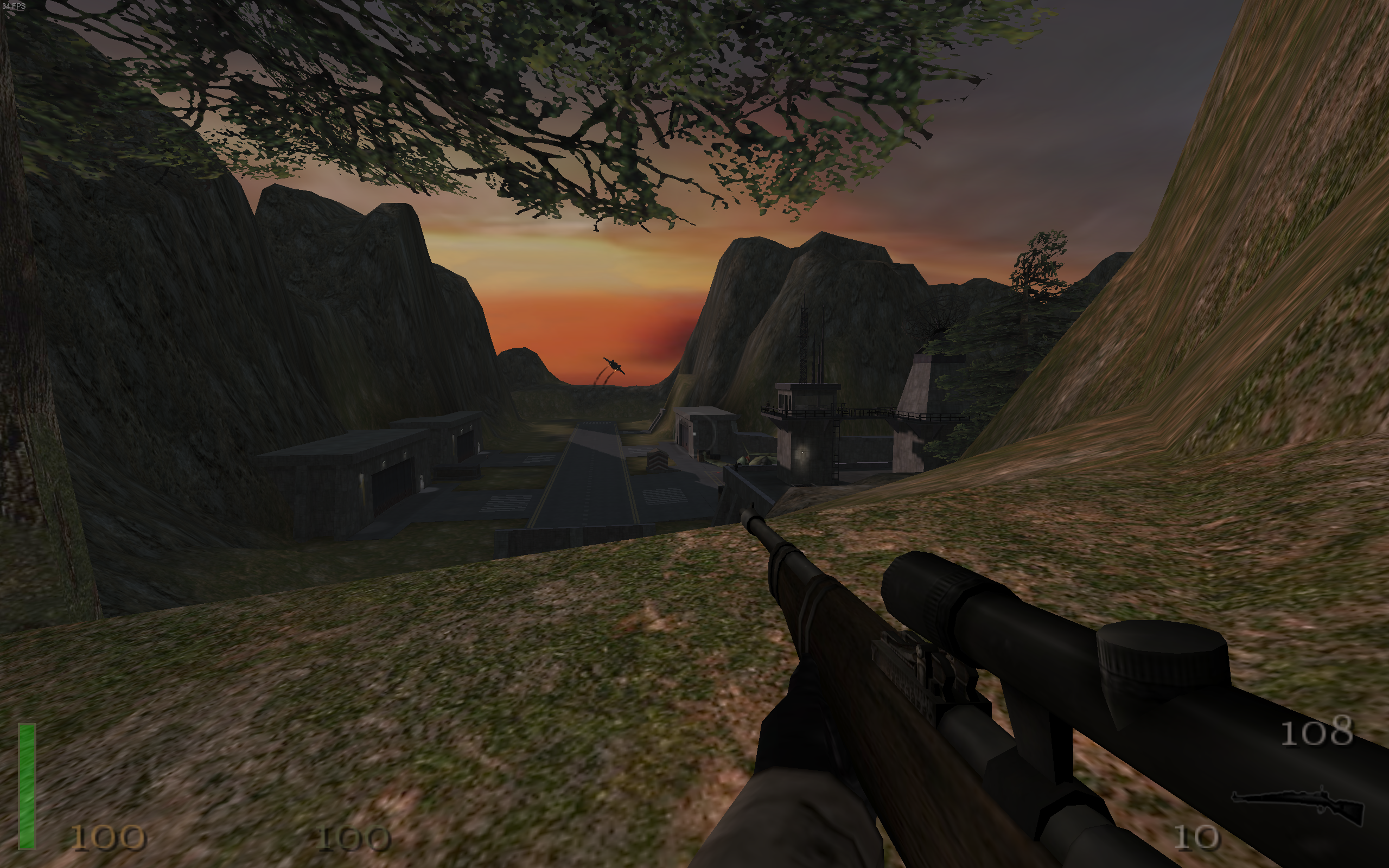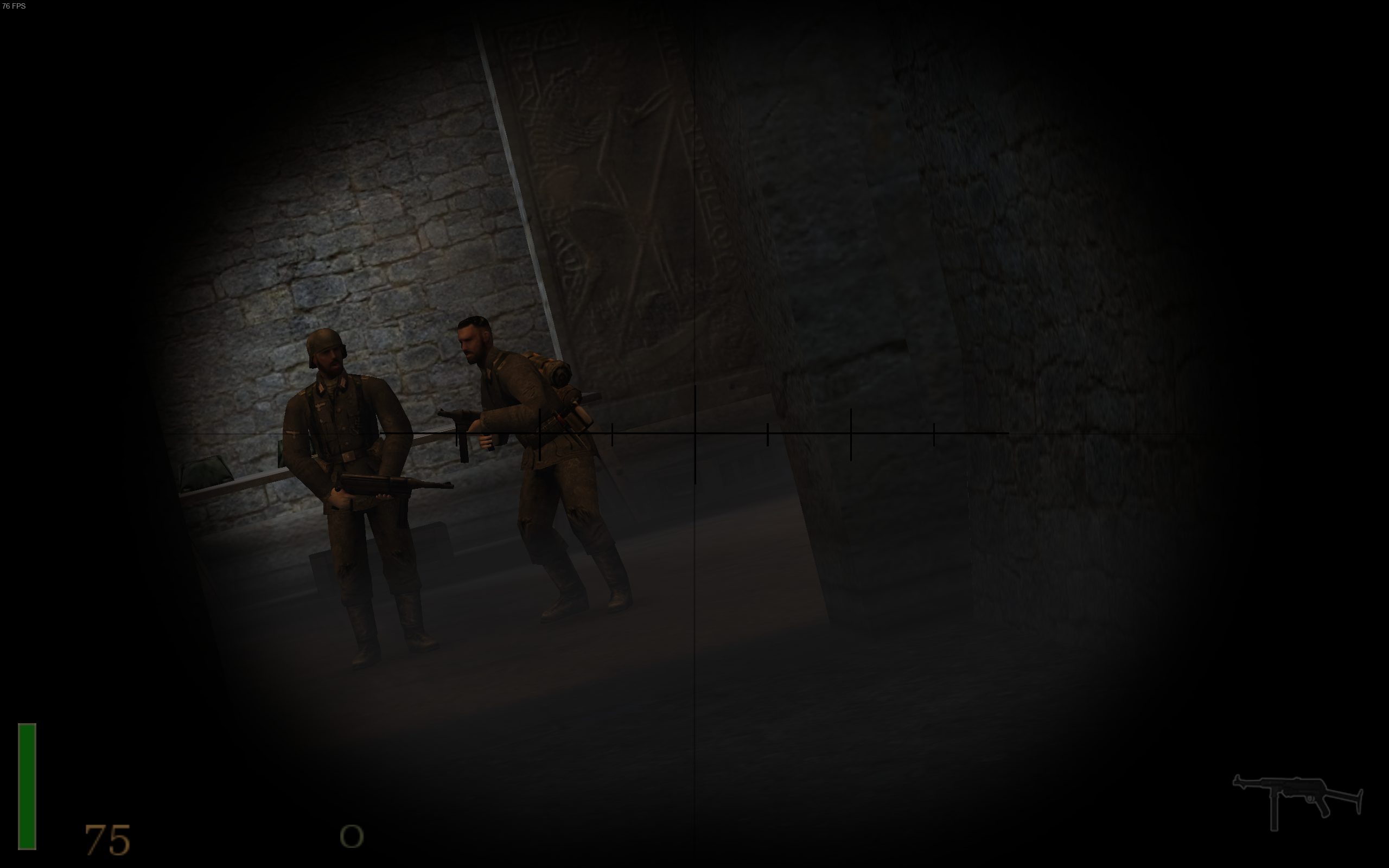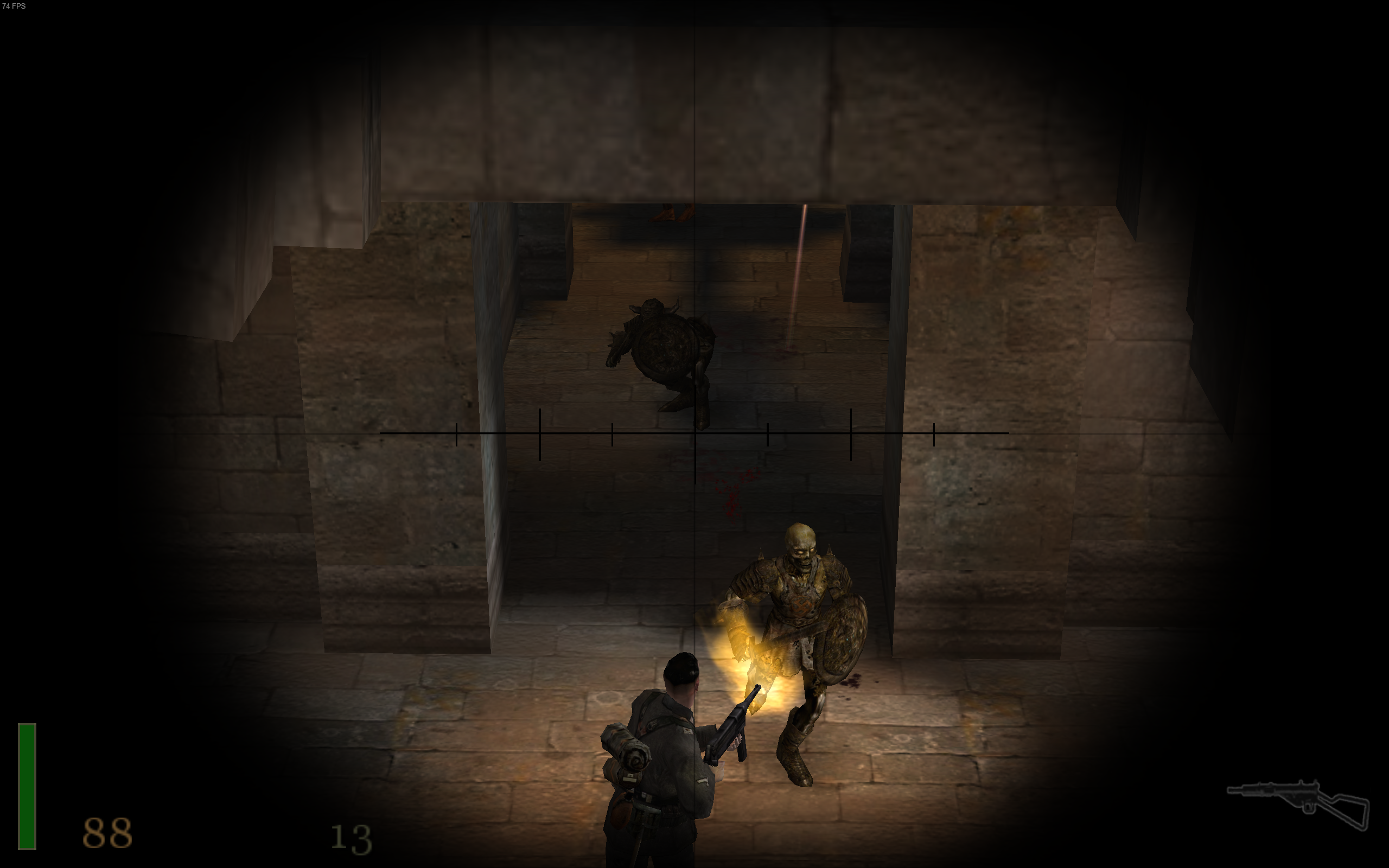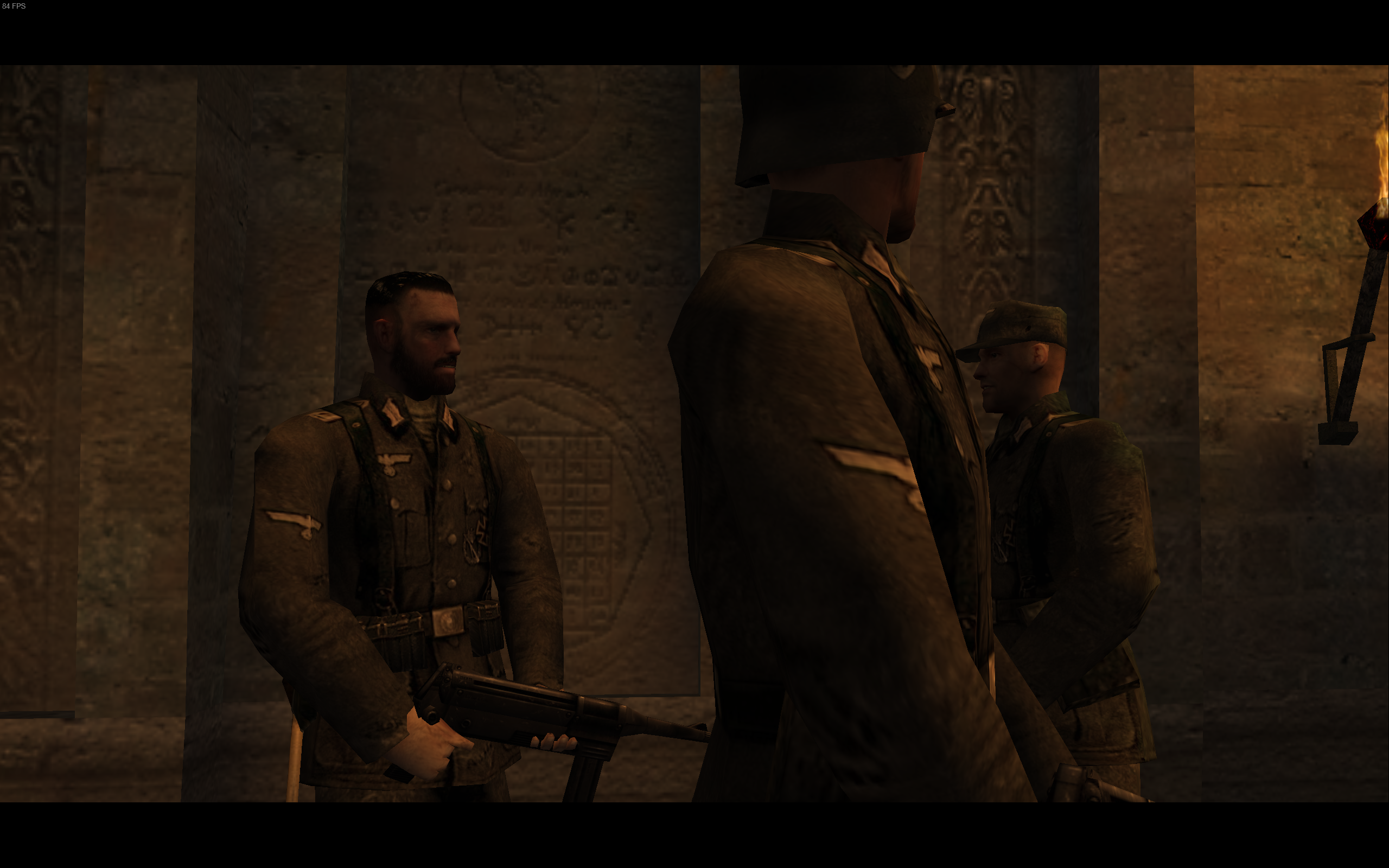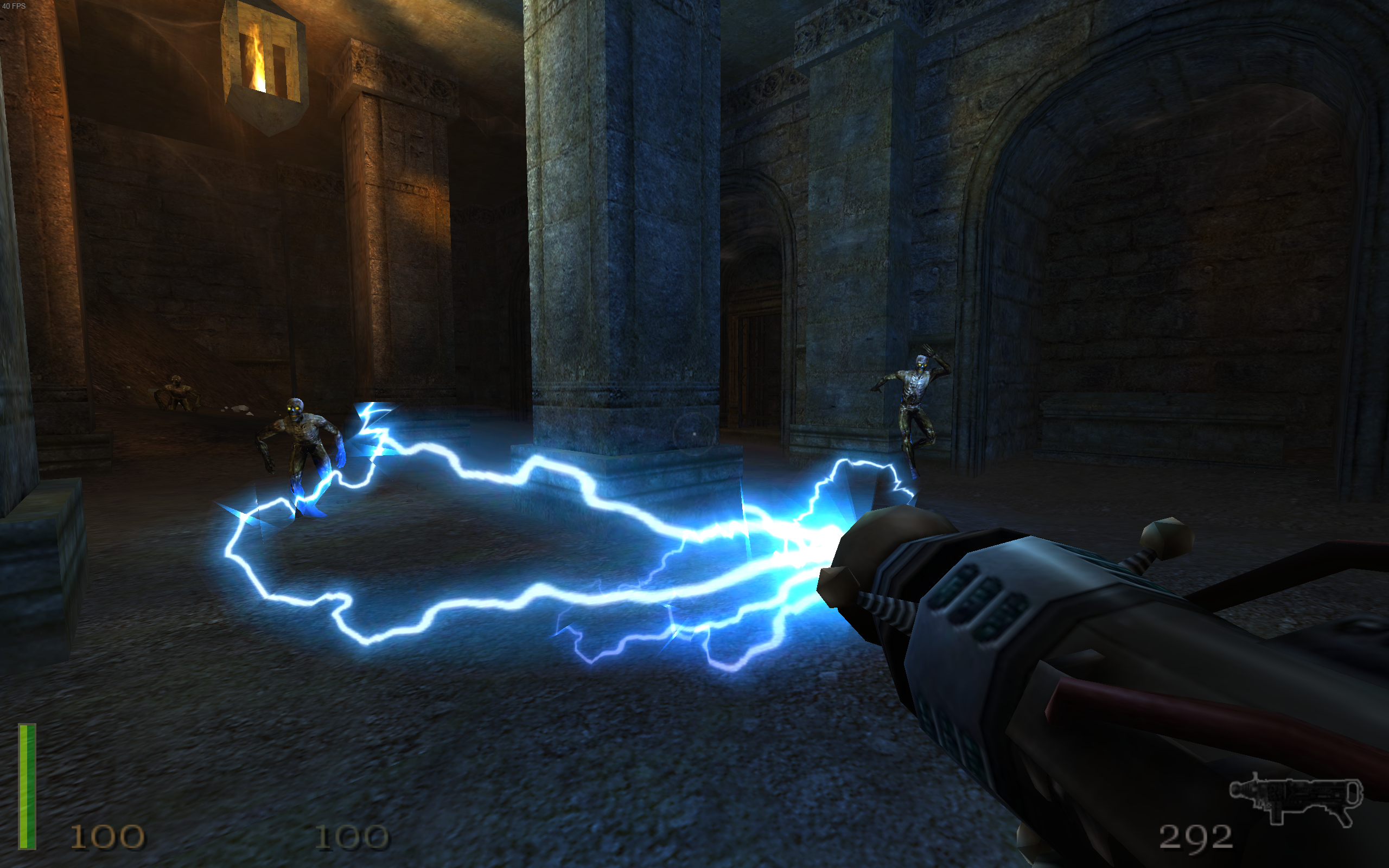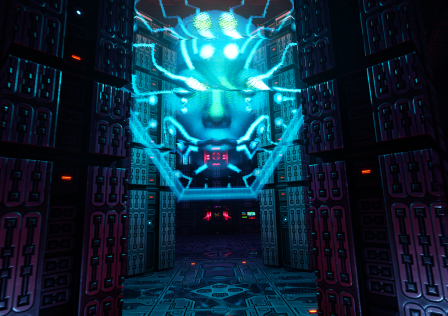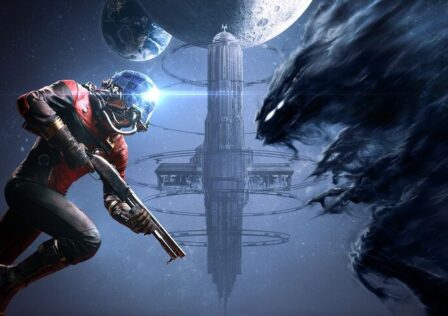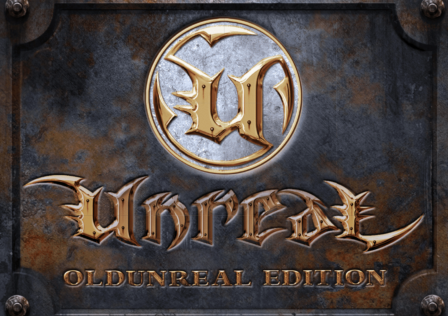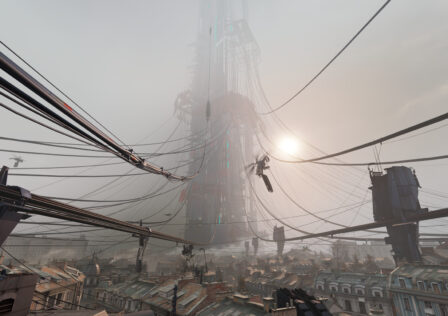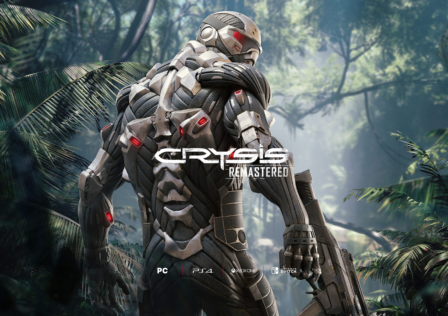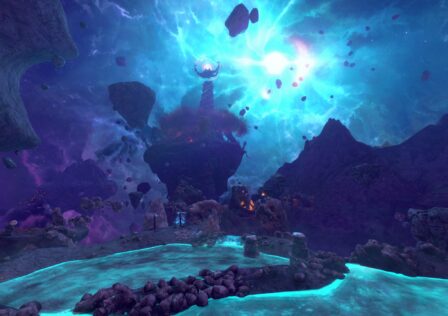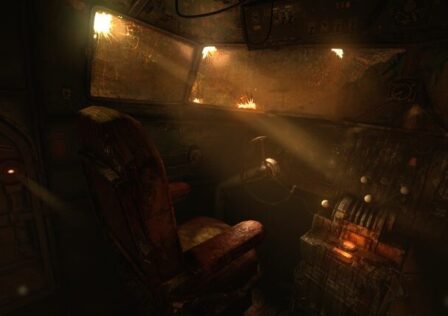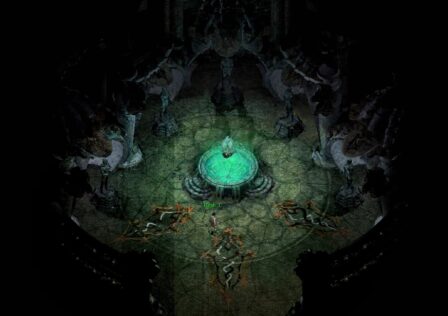Now time for a retro review! Return to Castle Wolfenstein was a game released in 2001 to great critical and fan acclaim for both its single-player and multi-player. The game is lauded as being the very best of the extremely long running Wolfenstein series and that says a lot considering the pedigree of the franchise. It’s influence was felt throughout many newer titles, from Battlefield to Call of Duty, STALKER to Metro 2033.
Was all of this fanfare warranted though?
Presentation
RTCW was a truly amazing visual spectacle way back in 2001. Running on a heavily modified Quake 3 engine and featuring high end features such as TruForm (tessellation), the game was a technological masterpiece for its time.
| 64-bit | No (custom engine versions allow for full 64-bit) |
|---|---|
| Linux Support | Native |
| Graphics API | OpenGL 1.1 (custom engine versions allow for OpenGL 3.3 features) |
| Frame Rate | 90 fps lock (custom engine versions allow for unlimited) |
| High Resolution Support | Yes |
| Ultrawide Support | Yes |
| High Refresh Rate Support | Yes |
| VR | No |
| Display HDR | No |
| Ray Tracing | No |
| Multicore CPU Support | 1-1.5 Cores (custom engine versions allow for 4-8) |
| Adjustable FOV | No (custom engine versions allow it to be modified) |
| Anisotropic Filtering | No (custom engine versions allow for 16x) |
| Anti-Aliasing | None (custom engine versions allow for MSAA x16) |
| Sound API | DirectSound (custom engine versions allow for OpenAL) |
| Sound | 2 channels |
| UI Scaling | No |
| Debug Console | Full |
| Modding | Open Source |
It is an example of early realistic, muscle-based facial animation technology that also managed to operate on characters dynamically according to the situation (in a manner similar to the tech later used in HL2 and TF2) as well as some really interesting and intense atmospheric effects and details thrown into the world. For example, the flame effects, especially from the flamethrower were absolutely unmatched for years when the game came out. It really does, for the first time in gaming, feel like a liquid dispense of hot death. Textures for some objects and clothes and weapons were done with photographs in order to achieve an incredible (for its time) level of fidelity as well as historical accuracy. Bump mapping was also used for added effect. Villages, castles and military installations were inspired and modeled after real world photos and locations with great care and attention to detail.
All of that is true and is… well valuable from a historic standpoint. The game has helped advance video game technology and a lot of what it has pioneered was valuable and still in use ( albeit enhanced) today. But let us not kid ourselves, the game has aged and the once amazing graphics will probably not amaze most gamers these days (less they are very curious and understand the time the game was released in that is). The texture and model quality by current day standards is relatively bad and the prebaked shadowing systems are not going to impress anyone (though it does look quite sharp).
Still, graphical fidelity, whilst important is not something that really makes the game. Not even visually. Art style and its consistency as well as execution both attribute to immersion and player experience more than pure fidelity. And here the game does not disappoint even 15 years later.
Wolfenstein has a very coherent and in a way somewhat unique aesthetic. It manages to feel cinematic long before that word started being misused by every second console developer. All of the many varied environments manage to feel both authentic and in a way also capture the aesthetic and style of iconic movies such as Indiana Jones as well as “Where Eagles Dare” and the iconic post World War 2 pulpy comic book war stories. The amazing thing in this case is that it manages to do all of that with all its fantastical elements as well. Mysterious catacombs filled with undead, forsaken ruins with traps or old castle corridors mingled with science fiction laboratories, full of bloody experiments and incredible experimental weaponry. They weave in and out of the main WW2 setting in a way that is truly masterful and coherent to a degree to which most other games simply cannot even hope to approach.
From the creepy horror levels, to the stealth missions in occupied villages, it all seems like a complete whole. Whether it be an zombified monsters, an elite Nazi soldier or a Cyborg Wunderwaffe, nothing feels out of place or forgotten or as an afterthought. It is a visual marvel really.
This really adds up to a lot and makes it so that once a brief adjustment period has passed, players even today should be able to immerse themselves no worse than the original target audience back in 2001. The art team responsible for the game really knew what they were doing, and their skill transcends time.
The sound of the game is also exceptional. The actual quality being output is not amazing by current day standards to be fair (not bad either, it works), but it is in no way a hindrance to the enjoyment of the tracks or sound effects in the title.
The OST is a work of art as it really feels like what Wolfenstein is supposed to be. Horror tunes and creepy haunting melodies sound natural and ominous, as do the bombastic high-octane orchestral pieces that simply make the player feel… well epic as all hell. The entire thing just sounds really good and very well thought out.
Sound effects also are a very good pick that meshes with the game’s vibe exceptionally well. The sound team used real alarm sounds for their game in order to add that little extra bit of authenticity. Weapons themselves sound beefy and powerful. There is a real mechanical feel from the way they are supposed to work (even the science fiction ones) as well as nice impact sounds (where applicable). Some special weapons make enemies react in certain ways. For example, a flamethrower will make human enemies scream in terror and move around trying desperately to extinguish the fire. The lightning Tesla Gun will make enemies recoil in pain and lose control over their bodies. Grisly stuff, sure, but also quite satisfying to use.
Voice acting. Cheesy, over the top at times, but earnest and natural. It had a good VA team for its time and due to the level of camp at play here, it still manages to feel fun and engaging and never really obnoxious. The few serious lines don’t feel out of place, but rather enhance the atmosphere of the Return’s situations and levels masterfully. This is what good balance and understand juxtaposition gets you. Alas, much to the disappointment of the more hardcore Wolfenstein fans, the German soldiers now speak accented English instead of actual German ![]() . Sure, it is very logical that BJ himself understand German and is in a sense “translating” it for the player… but it is a loss of a possible Bilingual bonus (that could have been solved with subtitles).
. Sure, it is very logical that BJ himself understand German and is in a sense “translating” it for the player… but it is a loss of a possible Bilingual bonus (that could have been solved with subtitles).
Speaking of atmosphere…that is something very dear to my heart. And Wolfenstein really understands that getting the player immersed is a central part in any gaming experience.
The combination of this consistent art style, visual and audio cues, logical yet good level design that is both interesting to play it yet still feels like a real place, smart AI and well the game knows how to nail a feeling down.
The trap ridden catacombs simply ooze despair and horror as frantic machine gun fire and screams of terror can be heard in the distance. Laboratories of dark science feel menacing and creepy in a very different way. The game was made for this, all of its art and audio design choices were chosen for it to be immersive. And it pays off for Return’s long term future. Handily.
Gameplay
Elegance. Purity of form. Simplicity and confidence in the proven design goals. No other way to describe it in a short manner.
Stealth was a component in Wolfenstein even before absurd high-octane action was. The first Castle Wolfenstein from the 80s is considered to be one of the first stealth games that laid the groundwork for the entire genre after it. Here RTCW really goes into its own form, for better and worse.
Many levels in the game are made in a way so as to allow a player to stealth through them OR at least get through a large portion of the level without being seen. Many of these ways are interwoven in the level design in a very natural way. For example, in one level, a player can use a crane and a trolley system to bypass half the level without even being seen. No mission marker tells you about this and you can simply observe the environment and some dialogue and find this manner of going through the level.
The way the stealth works is quite simple. You can backstab soldiers with your knife (no special animation, but a simple stab followed by an instant kill), you can crouch and lean over corners or walk slowly to be more quiet. This way you can open doors silently as well as listen to what NPCs have to say which often contains information that may help a stealth (and even Action) playstyle as well as contain other lore or game world information.
The player would do wisely to also be careful of alarms and even destroy them if possible before enemies get to them. If they do, they will not only put other enemies into battle mode (which makes them react faster and spot you easier if you are still attempting to sneak by them) but also often summon reinforcements and turn the orchestrated incursion into a bloody brawl. In fact this avoidance of the alarm is effectively a main objective in two missions, where Stealth is mandatory… really good stealth missions might I add, but they may piss off people that really like the action component of the game.
Unfortunately, you cannot move bodies around in the game nor turn of lights or blow off torches. Some options like using a soldier’s uniform are not in the game’s singleplayer portion (though they were in the original Wolfenstein and are in the multiplayer for ET). So in a sense, the stealth is well designed and very well balanced for a game of this type, but it is not super deep. And that is a shame I guess, as it is otherwise a really well done system with mostly complementing level design. In fact, dare I say, the pure stealth levels and their difficulty, tense and non-scripted nature are simply flat out better than the fairly easy, relaxed stealth levels of current AAA games, even if the mechanics underneath are not more complex. Some added complexity would have simply elevated it even more.
The other issue is that in some levels and scenarios, stealth is impossible by default. True, those are only a few levels and there are actual story reasons for that (logical ones), but still it can be somewhat disheartening for a gamer that likes the gameplay style.
High-octane action is another typical Wolfenstein component since the 90s. And oh boy the game is does it well!
Truth is the gunplay and the balance of the title is well thought out. It just feels right due to how the level design, enemy placement, their AI (which I will touch upon later), balance between said enemies and their abilities. It all comes together to feel organic and logical, concise. Bold and confident design choices all around make the action feel really good. It also helps that as a true old-school game, you can use all of your 16 weapons at any single time!
The weapons sound and act beefy, there is a sense of mechanical impact even if the once great animation work is now showing its age. The very feeling many of the weapons have is quite solid. The MP-40 and Thompson sound reliable and industrial, not weak weapons but workhorses as they should be for this game. The scoped Mauser rifle is a powerful, loud dealer of death. The Panzerfaust and its powerful “boom” and distortion effects make it feel lethal. Other superweapons like the Venom minigun are simply a joy to use and RTCW’s Flamethrower still feels sinister and effective on human and undead targets. Almost sadistically so. Stealth weapons like silenced Sten, the knife, and the prototype night-vision Snooper Rifle fit their roles as intended. Of course, the player’s trusty boot can also be used in true action hero fashion, though beware as it will alert enemies if used to kick open a door.
An interesting though gimmicky attack are the chairs. You can pick up a chair and use it in conjunction with your pistols and hit enemies with it. It is quite pointless overall though it does look cool and can also be used to find secrets (hurling the chair and then using it to climb on top of something).
Another (though small in the grand scheme of things) problem is how the Allied weapons simply lack ammo throughout the game. The Thompson and Colt 1911 are very decent but not over powered weapons, but their usage is quite limited due to the low amount of ammo. It makes sense since the player is mostly behind enemy lines, however it does leave the impression that an inventive way to give the player a bit more ammo was not developed.
The time to kill for most opponents AND the player is fairly short so the action can be very fast paced if a good player can execute it. You are quite fast and maneuverable, but also fairly fragile. To help you, headshots are devastating to almost all human enemies bar some of the elite soldiers. Here I must mention the AI, as that was a selling point for the game at the time. Soldiers are relatively smart even by modern day standards. They maneuver around the levels well, they can spot you and engage you in a logical fashion. Special and/or higher ranked soldiers aren’t just tougher and with better weapons but also use smarter tactics. The female Elite Guards can try to dodge and weave in and out of short and mid-range combat in an acrobatic and somewhat hard to predict manner. Meanwhile the paratrooper Black Guards can punt back your grenades, engage in very damaging melee combat against both Blazkowits and other enemy types. The heavy “Venom” soldiers are immune to flamethrowers and are just extremely tough and aggressive, tanking damage to help their comrades fight you.
The creatures you will encounter too display some impressive AI routines …occasionally. The Undead are quite stupid, true, but even they have interesting and varied attack types that I’d rather keep a surprise ![]() . Some mutated monsters are damaging and powerful not due to extreme armor or firepower, but rather their extreme agility and competence in moving in and out of the player’s range. They show impressive AI navigation, though I have seen them rarely wander off into stupid directions and get temporarily stuck on parts of the environment.
. Some mutated monsters are damaging and powerful not due to extreme armor or firepower, but rather their extreme agility and competence in moving in and out of the player’s range. They show impressive AI navigation, though I have seen them rarely wander off into stupid directions and get temporarily stuck on parts of the environment.
Human AI does manage to mostly obey all the tenants of good AI design. They are dynamic and change their behavior according to what is happening around them. Many of them can be quite challenging, and not really in a bullet-sponge type of way. Interesting routines, dialogue during combat as well as their interactivity with the environment makes them entertaining even outside of combat. It is not all sunshine and rainbows for the AI though as it has a few fatal flaws in the coordination department that modern games do not have (even if they have barely moved from RTCW in this area otherwise). They don’t seem to… register their allies’ position.
What this means is that whilst any individual soldier or monster can take cover or navigate quickly and effectively, they completely falter when as a group they are faced with an opposing force in tight quarters. Often the level design itself makes this not be a real problem as the enemies are generally in somewhat wide or complex spaces where they have space to maneuver and take cover without problems, but the silly issue remains and can at times take you out of the game or make taking them out easier than it should have otherwise been.
It also has to be mentioned that in the very few times a player has AI companions… they are quite incompetent and basically are too damn scripted for their own good. Which is a bummer.
Wolfenstein also does this where once action is getting more and more brutal, soundtracks change. From a calm military installation music to the epic “RTCW Action theme”. Sure it is somewhat illogical and arcade at heart but it does fit the title and its pace.
Other very important things one must note about the game are the way it handles secrets. Exploration too is a part of the classic Wolfenstein formula. Many levels have secret areas that often contain useful items or if nothing else, some gold that is used for nothing but bragging rights. The development team was inventive with how they modeled the gold and players can see a lot of interesting golden or silver creations there for the taking. Some secrets are easy or can be found by chance or even listening to some NPC banter. Others can be quite tough to find and may even require the player to remember background information from a previous level in order to be activated. The real triumph here is how well they are integrated into the game world. They do not feel like walled off content or some things added in only to toss a bone to completionist gamers. They are actual rewards for those that explore AND pay attention to the game world. The number of secrets is not high, but the quality of execution is REALLY impressive!
Also, RTCW has taken some cues from Half Life and very often the player can witness AI fighting against one another. Not only does this aid immersion to the enemies and be quite entertaining, but it does also let the player make his/her life easier. Just sit back and kill/sneak past the victor of these fights. In fact, in some levels one CAN even bait enemies around in order to see them fight or soften up both parties.
Environmental traps also exist in a few areas and again they fit quite nicely with the theme of their levels, though some of them can kill the player in a cheap fashion. Some more Indiana Jones stuff fits Return and DOES add to the gameplay and exploration in these certain areas of the game.
Storytelling
The great weakness of Wolfenstein? Well, not necessarily. The game does NOT take itself incredibly seriously and it does not rely on its story, narrative or characters. Those are mostly excuses for what is happening but despite all that, there WAS quite a bit of effort put into this aspect.
You won’t come to find deep characters here. The ones in the story are over the top, cheesy and quite stereotypical. They are engaging and the acting is good enough, that is true and they are fun whilst being a good fit for the narrative and tone, but depth of said characters or themes is not in great supply. Our protagonist, BJ Blaskowitz, is an almost complete blank slate for the player. The very little emotion he feels is only in couple of cutscenes.
Speaking of which, the game does rely on cut scenes between the big missions. The Office of Secret Actions for which our hero is working analyzes and comments on his findings and/or achievements whilst setting up the objectives for the next missions. This does give the player some sense of context to both their war contribution and a sense of belonging to an entity. Cheesy, simple, but effective.
With that being said, that is only a small part of the game’s storyline. What RTCW does well is environmental storytelling. Ironically RTCW, a supposedly big dumb shooter does understand the weaknesses and strengths of the medium really well. It understands how to integrate the pulp and camp of its own plot, the tone it sets AND manages to integrate it to both the level design and gameplay.
As previously mentioned, the title does rely on NPC banter quite a bit. And not all of it is about secrets or alternative ways to get through a level. Very often NPCs can tell stories or rumors to each other, in essence expanding on Return’s world building. This also serves to humanize the human soldiers, something that is quite sorely missing from many newer titles. These people, though monstrous … are still human beings that can feel fear or have families and even can display humor. That was something Bioshock Infinite did not quite have the galls to achieve, something many newer games do not do but is welcomed in RTCW. Actual basic humanization of the grunts you are fighting, and in decent quantities.
A lot of it can be cheesy dialogue, but that does not in any way feel out of place due to the tone set in the title. Sure you are in an insane cheesy action movie, but a very human and honest with itself one.
An interesting observation is just how globe-trotting of an adventure RTCW is. It does stand out compared to most games, easily. The combinations it can do with its own certain, at this point iconic image helps it establish a coherent vision as a part of a franchise. Self-referential to a point? Definitely, but the franchise is iconic and coherent enough in its own insanity to deserve it. Blaskowitz does escape the dungeons of Castle Wolfenstein. He manages to unearth occult secrets, stop super-weapons and fight a mad scientist. All things that are at this point a solid part of the identity of the series and it combines them all for the first (and so far only) time in its long history. It is very interesting to see how a game can in a sense both revere its past and its own iconography as well as its direct cinematic inspirations. Not getting lost in itself when combining so many elements of fiction and real world events is also impressive.
Other things the game does well are notes and documents. Often scattered around and sometimes main objectives to retrieve, these items contain information on characters and/or fluff about the world or weapons or what the evil plans of the Nazis are. Somewhat organic world building is established and the fictional version of WW2 is developed in the background of the game. Expanding the universe of the game whilst also letting the player peer into what other characters are thinking… which is appreciated as it gives at least some added depth to said characters and situations.
Multiplayer and Modding
In multiplayer, RTCW takes on a gameplay style that very few other games had tried at that point. It is basically a team game where you can choose to be either Axis or Allies. In most cases this meant that Axis had to defend an objective or area whilst the Allies tried to capture or take it. The maps are large, the objectives are well spruced along with excellent level design. To help the teams deal with the varied objectives, they could choose between four classes. You can be a soldier, a basic, fairly tough class with access to both standard guns as well as the Panzerfaust and Venom minigun. Medics can revive or heal their team mates but are limited to basic SMGs. Engineers are key to many maps and objectives. They have pliers as a sort of special weapon/tool that can take is instrumental to many of the main objectives as well as some of the secondary objectives (that may help your team), such as repairing a machine-gun. They also get dynamite! But again, limited in weaponry. The final class is the Lieutenant. Only one per team is allowed in the base game. They can choose from all weapons as well as issue orders via the voice chat. They can also call in air strikes via smoke grenades. Devastating attacks, but easy to avid less the players tunnel vision.
Generally on the maps, we have a sort of tug of war. Allies rush towards an objective trying to destroy it or steal it, whilst the Axis attempt to stop them. Usually, the key to the map is a dynamite with a 30 second timer. The game’s balanced map design, interesting environment and team-based gameplay later influenced many more titles. From the glorious upgraded version of its own self, called Enemy Territory Wolfenstein, to Battlefield and Team Fortress 2 (RTCW ironically being inspired in some cases by Team Fortress 1).
The modding community ate up the game. Popular multi-player mods with advanced features or rules, mini-campaigns with their own storylines and levels… it is not easy to find all of these little gems but they exist. The community still exists making maps and stuff, but their exploits are lower due to the game’s age. Still a lot of extra content, some of it middling, some of it good awaits the fan of RTCW.
Overall
And now we are at the end of this article… and so far it seems as if I am extremely positive about RTCW. And that is correct, the game is well, quite elegant and confident. It is an old game, but almost nothing in it really feels dated or old. It is pure and no-nonsense in almost all it does. There is NO such beast as a perfect game, nor a game for everyone and RTCW is no exception. But honestly, it is a title that understands what it is and what it wants to be. It is an action first person shooter that is proud of what it is, warts and all. One with stupid but at the same time glorious paranormal and science fiction elements. A mechanic heavy creation, but one that does not shy away from world building and gets the so far established tenants of storytelling in gaming surprisingly well.
Alternate WW2 is a setting it takes to its heart and it is definitely a game I’d consider being made with care, attention and love. And personally, at least for me it is one of the finest first person shooter titles of all time.
- Presentation: Nothing bad here. It has a lot of options, runs well and was damn excellently optimized for its time. Very good art style that ties in all the game’s environments. Excellent sound effects and great music are essential and the developers knew that. A fan patch can be easily applied to help the game use newer aspect ratios, but that is to be expected. It is a PC game and it shows. 19/20
- Story: Surprisingly, the game understands how to use its genre and medium really well. Do NOT expect complex themes or characters or ideas (even by video game standards), but do expect a surprisingly involving and well thought out plot with solid world building that uses the medium’s strengths to boost itself. It knows it is an action game and is damn proud of it, unlike the movies we call FPS games nowadays. 14/20
- Gameplay: Elegance, simplicity… unexpected depth. I can say only good things about it. Thankfully many good linear shooters like Metro have learned their lessons from RTCW. It is not extremely complex but it is very well balanced and thought out. Polished to a shine few games attain. 19/20
- Audio & Visuals: For its time it was a Crysis or Doom 3 level event. Extremely good looking by 2001/2002 standards and very scalable. Pioneered some interesting lighting and animation techniques as well as many cinematic special effects. Even used an early form of tessellation. Of course it has aged, but the fact that the game’s atmosphere will not diminish even 15 years later is a testament to both the it’s art department as well as its tech team. 20/20
- Lasting Appeal: It is a linear shooter, true, but the replayability due to the excellent level design is top notch and can potentially give a player a decent amount of extra content. A dedicated modding community as well as some excellent multiplayer (which is now almost entirely moved onto Enemy Territory: Wolfenstein ) does give the game great extra staying power. Lots of maps and mini campaigns exist for those who look for them. Some quite decent… others not so much. Still, it is a game built to feel complete and for PC Gamers. 18/20
- Overall: 90/100 (A classic of its genre!)

Here are some related links about Return to Castle Wolfenstein that I find interesting:

